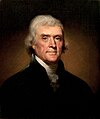Benjamin Stoddert
This article includes a list of general references, but it lacks sufficient corresponding inline citations. (December 2022) |
Benjamin Stoddert | |
|---|---|
 | |
| 1st United States Secretary of the Navy | |
| In office June 18, 1798 – March 31, 1801 | |
| President | John Adams Thomas Jefferson |
| Preceded by | Robert Morris (Agent of Marine) |
| Succeeded by | Robert Smith |
| Personal details | |
| Born | 1751 Charles County, Maryland, British America |
| Died | December 18, 1813 (aged 61–62) Bladensburg, Maryland, U.S. |
| Political party | Federalist |
| Spouse | Rebecca Lowndes |
| Education | University of Pennsylvania |
Benjamin Stoddert (1751 – 18 December 1813) was the first United States Secretary of the Navy from 1 May 1798 to 31 March 1801.
Early life and education
Stoddert was born in
Career
In 1783, Stoddert established a
After

In May 1798, President
Stoddert concerned himself with the Navy's daily administration and operations and the service's future strength. He established the first six navy yards and advocated building twelve
Following the peace accord with France, the U.S. Navy's personnel strength and the number of active vessels were reduced. The
Stoddert established the Navy Department Library due to instructions received from President Adams in a letter dated 31 March 1800.

He left office in March 1801 to return to commercial life. Following his term as Secretary of the Navy, Stoddert's final years witnessed a decline in his fortunes: as Stoddert lost heavily in land speculation, Georgetown declined as a commercial center, and the Embargo and the War of 1812 brought American overseas trade to a halt. During this period, he lived at Halcyon House, on the corner at 3400 Prospect Street NW.[3]
Stoddert died on 13 December 1813 and is buried in the graveyard at Addison Chapel, Seat Pleasant, Maryland.
Things named for Benjamin Stoddert
- Two Navy ships: USS Stoddert (DD-302), 1920–1935, and USS Benjamin Stoddert (DDG-22), 1964–1991
- Fort Stoddert in the Mississippi Territory (today Alabama)
- Benjamin Stoddert Middle School in Waldorf, Maryland
- Benjamin Stoddert Middle School Archived 2015-04-03 at the Wayback Machine in Temple Hills (Marlow Heights), Maryland
- Benjamin Stoddert Elementary School in Washington D.C.
In the
In Landover, Maryland there is a residential street named after him.
Notes and references
- ^ a b Peter, Grace Dunlop (1933). A Portrait of Old Georgetown. Garrett & Massie, Inc. p. 12.
- ^ Scharf, J. Thomas (1879). History of Maryland: From the Earliest Period to the Present Day. Baltimore: John B. Piet. Vol. II, p. 437.
- ^ Candyce H. Stapen (2000), Washington DC Blue Guide (London: A&C Black, Publishers), p. 572
- ISBN 9780722294475. Retrieved 16 April 2018 – via Google Books.
- ^ 38°54′37″N 77°03′31″W / 38.910354°N 77.058481°W
References
 This article incorporates public domain material from websites or documents of the Naval History and Heritage Command.
This article incorporates public domain material from websites or documents of the Naval History and Heritage Command.- This article incorporates text from the public domain Dictionary of American Naval Fighting Ships.





